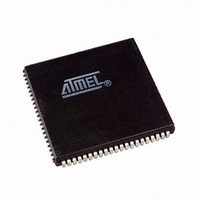AT6002LV-4JC Atmel, AT6002LV-4JC Datasheet - Page 4

AT6002LV-4JC
Manufacturer Part Number
AT6002LV-4JC
Description
IC FPGA HP 4NS 6000 GATES 84PLCC
Manufacturer
Atmel
Series
AT6000(LV)r
Datasheet
1.AT6002-4JC.pdf
(28 pages)
Specifications of AT6002LV-4JC
Number Of Logic Elements/cells
1024
Number Of I /o
64
Number Of Gates
6000
Voltage - Supply
3.135 V ~ 3.465 V
Mounting Type
Surface Mount
Operating Temperature
0°C ~ 70°C
Package / Case
84-PLCC
Lead Free Status / RoHS Status
Contains lead / RoHS non-compliant
Number Of Labs/clbs
-
Total Ram Bits
-
Each cell, in addition, provides the ability to route a signal
on a 90 turn between the NS1 bus and EW1 bus and
between the NS2 bus and EW2 bus.
Express buses are not connected directly to cells, and thus
provide higher speeds. They are the fastest way to cover
long, straight-line distances within the array.
Each express bus is paired with a local bus, so there are
two express buses for every column and two express
buses for every row of cells.
Connective units, called repeaters, spaced every eight
cells, divide each bus, both local and express, into
segments spanning eight cells. Repeaters are aligned in
rows and columns thereby partitioning the array into 8 x 8
sectors of cells. Each repeater is associated with a
local/express pair, and on each side of the repeater are
connections to a local-bus segment and an express-bus
segment. The repeater can be programmed to provide any
one of twenty-one connecting functions. These functions
are symmetric with respect to both the two repeater sides
and the two types of buses.
Among the functions provided are the ability to:
• Isolate bus segments from one another
• Connect two local-bus segments
• Connect two express-bus segments
• Implement a local/express transfer
Figure 4. Cell Structure
4
AT6000(LV) Series
In all of these cases, each connection provides signal
regeneration and is thus unidirectional. For bidirectional
connections, the basic repeater function for the NS2 and
EW2 repeaters is augmented with a special programmable
connection allowing bidirectional communication between
local-bus segments. This option is primarily used to imple-
ment long, tristate buses.
The Cell Structure
The Atmel cell (Figure 4) is simple and small and yet
can be programmed to perform all the logic and wiring
functions needed to implement any digital circuit. Its four
sides are functionally identical, so each cell is completely
symmetrical.
Read/write access to the four local buses – NS1, EW1,
NS2 and EW2 – is controlled, in part, by four bidirectional
pass gates connected directly to the buses. To read a local
bus, the pass gate for that bus is turned on and the three-
input multiplexer is set accordingly. To write to a local bus,
the pass gate for that bus and the pass gate for the associ-
ated tristate driver are both turned on. The two-input
multiplexer supplying the control signal to the drivers per-
mits either: (1) active drive, or (2) dynamic tristating
controlled by the B input. Turning between L
between L
two associated pass gates. The operations of reading, writ-
ing and turning are subject to the restriction that each bus
can be involved in no more than a single operation.
NS2
and L
EW2
is accomplished by turning on the
NS1
and L
EW1
or













